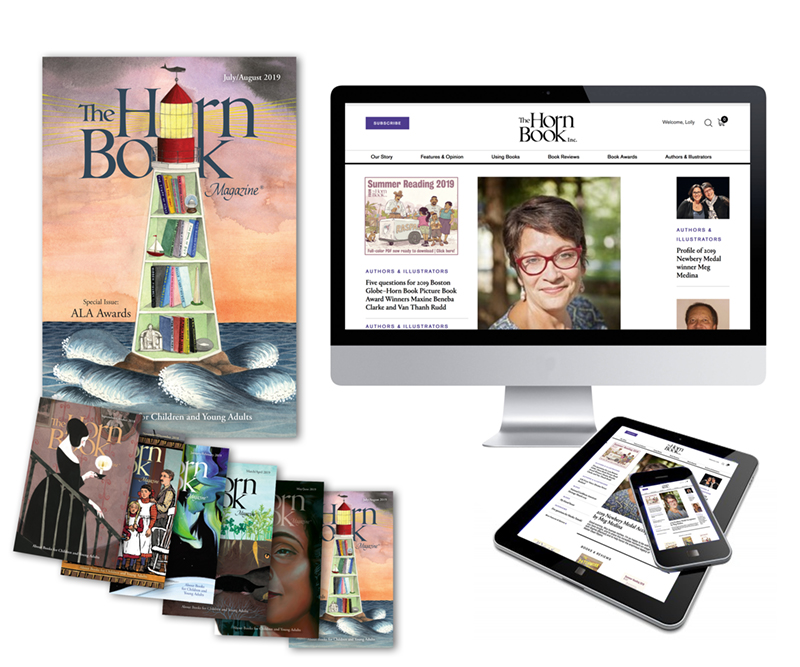2018 School Spending Survey Report
Poetry and pictures
Poetry appears in many forms in these four illustrated books: one collection of old favorites, two books that present original poetry in both Spanish and English, and one biography of an enslaved man who became a poet.
 JooHee Yoon's sixteen selections of poems about animals in Beastly Verse include the usual suspects from Nash, Blake, Belloc, and other favorite poets, but the pictures are the collection's highlight. Belloc's yak, for example, is a big red scribbly beast planted firmly in a snowy mountain landscape. The book is big and square and sturdy, with thick off-white paper contrasting with the embellishment Yoon pours onto each animal and scene via overlays of three primary colors. But as eye-catching as the pictures are, the artist knows to pay attention to the poems and reflect their moods. (Enchanted Lion, 3–6 years)
JooHee Yoon's sixteen selections of poems about animals in Beastly Verse include the usual suspects from Nash, Blake, Belloc, and other favorite poets, but the pictures are the collection's highlight. Belloc's yak, for example, is a big red scribbly beast planted firmly in a snowy mountain landscape. The book is big and square and sturdy, with thick off-white paper contrasting with the embellishment Yoon pours onto each animal and scene via overlays of three primary colors. But as eye-catching as the pictures are, the artist knows to pay attention to the poems and reflect their moods. (Enchanted Lion, 3–6 years) Written first in Spanish then translated into English by author-illustrator Julie Paschkis, each poem in Flutter & Hum: Animal Poems / Aleteo y Zumbido: Poemas de Animales is intricately connected to its corresponding painting, with additional, thematic words found throughout the pictures. The colors and line-work in the gouache illustrations vary according to the subject: the playful dog is all bright colors and curving, bouncy balls, while the crow is dark with sharp edges and straight lines. Readers will find themselves carefully studying every little detail of the pictures while being charmed by the poems. (Holt, 3–6 years)
Written first in Spanish then translated into English by author-illustrator Julie Paschkis, each poem in Flutter & Hum: Animal Poems / Aleteo y Zumbido: Poemas de Animales is intricately connected to its corresponding painting, with additional, thematic words found throughout the pictures. The colors and line-work in the gouache illustrations vary according to the subject: the playful dog is all bright colors and curving, bouncy balls, while the crow is dark with sharp edges and straight lines. Readers will find themselves carefully studying every little detail of the pictures while being charmed by the poems. (Holt, 3–6 years) Jorge Argueta creates a mouth-watering musical recipe in Salsa: Un poema para cocinar. As a boy and his family prepare their weekly salsa roja, the child's imagination runs wild. Ingredients become musical instruments—an onion is a maraca, tomatoes are bongos and kettledrums. Argueta's use of onomatopoeia and detailed descriptions play on the various senses to convey the sounds, flavors, and feelings coming together as the boy's family dances, sings, and cooks. Duncan Tonatiuh's illustrations, rendered primarily in greens and reds, complement the two types of salsa mentioned in the poem. A message of love and family creating something special shines through. (Groundwood, 4–7 years)
Jorge Argueta creates a mouth-watering musical recipe in Salsa: Un poema para cocinar. As a boy and his family prepare their weekly salsa roja, the child's imagination runs wild. Ingredients become musical instruments—an onion is a maraca, tomatoes are bongos and kettledrums. Argueta's use of onomatopoeia and detailed descriptions play on the various senses to convey the sounds, flavors, and feelings coming together as the boy's family dances, sings, and cooks. Duncan Tonatiuh's illustrations, rendered primarily in greens and reds, complement the two types of salsa mentioned in the poem. A message of love and family creating something special shines through. (Groundwood, 4–7 years) Poet: The Remarkable Story of George Moses Horton by Don Tate is the story of a man who taught himself to read and compose poetry, and who lived as a slave until age sixty-six. When George Moses Horton finds an audience at the University of North Carolina, where he sells fruits and vegetables on weekends, he becomes a paid poet, delivering love poems aloud and finally learning to write from a professor's wife. Tate's gouache, ink, and pencil illustrations are as straightforward as his text, but still pack an emotional punch. Young readers may need an adult to explain the historical context, but this is a compelling story for any age, by turns sad and uplifting. (Peachtree, 4–7 years)
Poet: The Remarkable Story of George Moses Horton by Don Tate is the story of a man who taught himself to read and compose poetry, and who lived as a slave until age sixty-six. When George Moses Horton finds an audience at the University of North Carolina, where he sells fruits and vegetables on weekends, he becomes a paid poet, delivering love poems aloud and finally learning to write from a professor's wife. Tate's gouache, ink, and pencil illustrations are as straightforward as his text, but still pack an emotional punch. Young readers may need an adult to explain the historical context, but this is a compelling story for any age, by turns sad and uplifting. (Peachtree, 4–7 years)From the August 2015 issue of Notes from the Horn Book.
RELATED
RECOMMENDED






Add Comment :-
Be the first reader to comment.
Comment Policy:
Comment should not be empty !!!